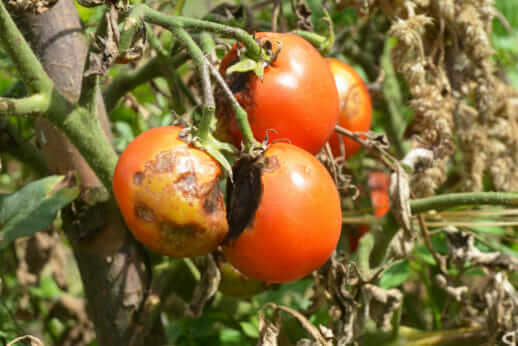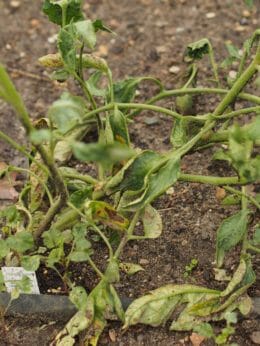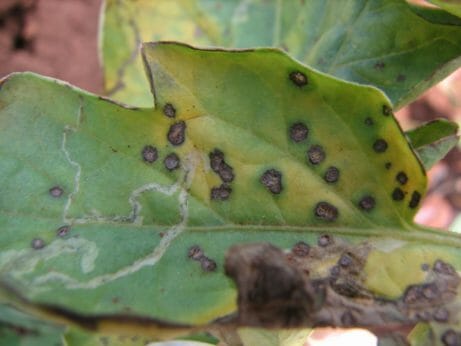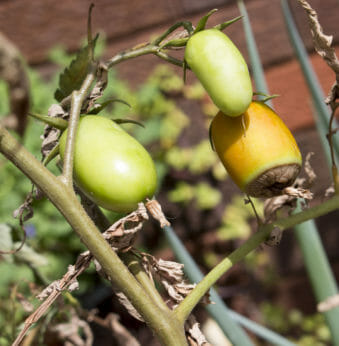Ask Modern Farmer: What’s Wrong with my Tomato Plants?
Blights, wilts, spots and rots: a complete guide to diagnosing and dealing with the ugly foes attacking your heirloom beauties.
Ask Modern Farmer: What’s Wrong with my Tomato Plants?
Blights, wilts, spots and rots: a complete guide to diagnosing and dealing with the ugly foes attacking your heirloom beauties.

Do you have a question for Modern Farmer? Tweet it to us @ModFarmer, or write us at [email protected]
Warm, wet weather encourages the growth of most tomato diseases. They spread slowly in spring and early summer, and often go undetected at first. Then suddenly, by mid-July, your tomato plants look like they’ve been through a war: half the leaves are yellow, while your nearly ripe fruit is suddenly splotched with oozing sores.
What went wrong?
Here’s our guide to diagnosing, and dealing with, the most common tomato diseases. While you might be inspired to make a last-ditch effort to save the crop, the sad truth is there is little you can do once disease takes hold. In mild cases, you might be able to obtain a modest harvest from an infected plant, but in severe cases even bombing your tomatoes with chemical fungicides will have little effect. A better bet is to make a plan for how to prevent the problem next year.
Blights
Tomato blights come in two forms: early and late.
Early blight causes ¼- to ½-inch brown splotches on the leaves, with a characteristic yellow “halo” around each one. The disease starts on the lowest leaves early in the season and works its way up. If the weather remains on the dry side, the plants typically survive, though yields may be reduced. In wet weather, the disease can consume the plant, causing the fruit to rot before it ripens.
Late blight is a bit of a misnomer, as it can occur at any time in the season; though it rarely makes itself known before midsummer. Unlike early blight, the “late” version causes discoloration all over the plant. Late blight is the more aggressive of the two, often destroying the crop in short order.

Wilts
Several insidious diseases cause tomato plants to rapidly wilt and die.
The visual cues for verticillium wilt and fusarium wilt, two of the most common, are nearly identical. Like early blight, the symptoms typically start at the base of the plant and work their way up. But rather than splotches of discoloration, the leaf wilts and turns yellow. Another telltale sign: in the earliest stages, the yellowing often occurs only on one side of the plant, or sometimes just on one side of individual leaves. The main difference between the two is that fusarium is more common in hot weather, while verticillium prevails in cool spells.
Plants suffering from bacterial wilt meet the same fate, but this disease starts at the top of the plant and works its way down. Because the leaves remain green at first, bacterial wilt is often mistaken as a sign that the plant needs water. No amount of irrigation causes it to recover, however, and the leaves quickly turn yellow and die.

Cankers
Cankers are deadly tomato diseases that start with discolored leaves and eventually lead to oozing lesions on stems and fruit.
There are two main types. The most common is bacterial canker, characterized by the appearance of small brown lesions with a white halo on green fruit; the spots eventually grow into raised humps. Alternaria canker, the other type, is characterized by sunken gray lesions on ripening fruit.

Spots
Numerous tomato diseases include the words “spot” or “speck,” but the most common by far is Septoria leaf spot. The symptoms resemble those of early blight: small round spots appear on the lower leaves, eventually colonizing the entire plant. Unlike early blight, however, the discolorations caused by Septoria leaf spot lack a yellow halo; they are distinguished instead by a black dot in the middle.

Rots
The number of tomato diseases that include the word “rot” is too long to list. Some rots (a generic term for various fungal diseases) attack the roots or leaves first, but perhaps the most worrisome are those that go straight for the fruit. These often show up on perfectly ripe fruit, sometimes even after it has been picked. The location and appearance of the rot depend on the pathogen in question.
NOTE: It’s important to note, however, that blossom end rot, one of the most common of the so-called rots, is not the result of a pathogen, but of a calcium deficiency in the soil. Blossom end rot is characterized by soggy brown flesh at the base of the fruit opposite the stem.

There is no cure, per se, for any of the diseases listed here. But there are ways to prevent their spread.
Fungicides
Chemical warfare can help prevent tomato diseases from becoming established, but this means spraying on a weekly basis starting from the day the tomatoes are transplanted. Natural alternatives include copper sprays, Bordeaux mixture and biological products like Serenade. But keep in mind that, while natural, many of these products still have a detrimental impact on human health and the environment when used frequently.
Cultivation Methods
Here are a few tips for managing your tomatoes to prevent the spread of disease:
Plant Disease-Resistant Varieties
That series of letters you see next to the cultivar name on the nursery label or seed catalog listing? It’s a code for the diseases that the variety is resistant to.
The most commonly seen designation is “VFN,” which refers to varieties resistant to verticillium and fusarium wilts, plus nematodes, a soil-dwelling insect that attacks tomato roots. But breeders have developed tomatoes that are resistant to many other diseases. Click here for a comprehensive list of disease-resistant varieties and here a list of disease resistance codes.
Follow us
This work is licensed under a Creative Commons Attribution-NoDerivatives 4.0 International License.
Want to republish a Modern Farmer story?
We are happy for Modern Farmer stories to be shared, and encourage you to republish our articles for your audience. When doing so, we ask that you follow these guidelines:
Please credit us and our writers
For the author byline, please use “Author Name, Modern Farmer.” At the top of our stories, if on the web, please include this text and link: “This story was originally published by Modern Farmer.”
Please make sure to include a link back to either our home page or the article URL.
At the bottom of the story, please include the following text:
“Modern Farmer is a nonprofit initiative dedicated to raising awareness and catalyzing action at the intersection of food, agriculture, and society. Read more at <link>Modern Farmer</link>.”
Use our widget
We’d like to be able to track our stories, so we ask that if you republish our content, you do so using our widget (located on the left hand side of the article). The HTML code has a built-in tracker that tells us the data and domain where the story was published, as well as view counts.
Check the image requirements
It’s your responsibility to confirm you're licensed to republish images in our articles. Some images, such as those from commercial providers, don't allow their images to be republished without permission or payment. Copyright terms are generally listed in the image caption and attribution. You are welcome to omit our images or substitute with your own. Charts and interactive graphics follow the same rules.
Don’t change too much. Or, ask us first.
Articles must be republished in their entirety. It’s okay to change references to time (“today” to “yesterday”) or location (“Iowa City, IA” to “here”). But please keep everything else the same.
If you feel strongly that a more material edit needs to be made, get in touch with us at [email protected]. We’re happy to discuss it with the original author, but we must have prior approval for changes before publication.
Special cases
Extracts. You may run the first few lines or paragraphs of the article and then say: “Read the full article at Modern Farmer” with a link back to the original article.
Quotes. You may quote authors provided you include a link back to the article URL.
Translations. These require writer approval. To inquire about translation of a Modern Farmer article, contact us at [email protected]
Signed consent / copyright release forms. These are not required, provided you are following these guidelines.
Print. Articles can be republished in print under these same rules, with the exception that you do not need to include the links.
Tag us
When sharing the story on social media, please tag us using the following: - Twitter (@ModFarm) - Facebook (@ModernFarmerMedia) - Instagram (@modfarm)
Use our content respectfully
Modern Farmer is a nonprofit and as such we share our content for free and in good faith in order to reach new audiences. Respectfully,
No selling ads against our stories. It’s okay to put our stories on pages with ads.
Don’t republish our material wholesale, or automatically; you need to select stories to be republished individually.
You have no rights to sell, license, syndicate, or otherwise represent yourself as the authorized owner of our material to any third parties. This means that you cannot actively publish or submit our work for syndication to third party platforms or apps like Apple News or Google News. We understand that publishers cannot fully control when certain third parties automatically summarize or crawl content from publishers’ own sites.
Keep in touch
We want to hear from you if you love Modern Farmer content, have a collaboration idea, or anything else to share. As a nonprofit outlet, we work in service of our community and are always open to comments, feedback, and ideas. Contact us at [email protected].by Brian Barth, Modern Farmer
July 24, 2018
Modern Farmer Weekly
Solutions Hub
Innovations, ideas and inspiration. Actionable solutions for a resilient food system.
ExploreExplore other topics
Share With Us
We want to hear from Modern Farmer readers who have thoughtful commentary, actionable solutions, or helpful ideas to share.
SubmitNecessary cookies are absolutely essential for the website to function properly. This category only includes cookies that ensures basic functionalities and security features of the website. These cookies do not store any personal information.
Any cookies that may not be particularly necessary for the website to function and are used specifically to collect user personal data via analytics, ads, other embedded contents are termed as non-necessary cookies.
Hi A few years ago one morning during a hot and humid period I noticed one of my Tomato plants was wilting at the top of the plant and by the end of the day the whole plant was wilted and dead . I pulled it out and after losing three out of five plants I researched it and found out the culprit was Bacterial Wilt . I found out there was nothing I could do at this point so I tried an experiment . I found out silver was a natural antibiotic so I bought an 8 ounce bottle… Read more »
Gary Oh but a vine ripened tomato tastes so good compared to one bought from a store . Well worth the effort !
I planted Celebrity Tomatoes in Mid May and soon after they were in the ground, I noticed that the leaves were looking odd. Not really curling, but that is the only way to describe how they looked. Almost like the stem was growing, but the leaves were not. I planted again, a different variety this time, and the same thing happened. The third and last time I planted was about 3 weeks ago, and so far, they are doing okay. I would like to show you a photo, but don’t know how to do so. Also, this is a new… Read more »
OOPS I LOST 3 OUT OF EIGHT PLANTS !
I’ve found that a one to ten mix of hydrogen peroxide to water sprayed on my veggies (under the leaves as well) has been a great deterrent to 98% of insect or other bio attackers in my garden. It can be mixed and poured around the base of the plants as well. Good luck with your gardens.
I started some organic tomatoes from seeds, they do have a little blight but the tomatoes look good
hi everyone. I noticed a couple of tomatoes on two plants are showing discoloration. See attached photo. Any ideas on what is causing this?
My tomatoes are growing great but, they are beautiful red and then yellow about 1/4 of the top. Why?
Hello My tomatoes are rooting all the way to the top and not producing any tomatoes .I have 7 plants and 4 tomatoes 1on 1 and 4 on1 6 of them are big boys and 1 is better boy .planted them the last week of April .live in South Carolina. Plants are beautiful